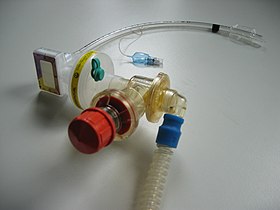
Back حفظ الحياة (طب) Arabic Suport vital Catalan Soporte vital Spanish Bizia mantentze Basque जीवन आधार Hindi 延命治療 Japanese Организмді тірілту Kazakh Реанимация Kirghiz Suporte à vida Portuguese Интенсивная терапия Russian
This article is written like a personal reflection, personal essay, or argumentative essay that states a Wikipedia editor's personal feelings or presents an original argument about a topic. (November 2023) |
| Life support | |
|---|---|
 Endotracheal tube of an emergency ventilator system | |
| Specialty | Emergency medicine, intensive care medicine |
Life support comprises the treatments and techniques performed in an emergency in order to support life after the failure of one or more vital organs. Healthcare providers and emergency medical technicians are generally certified to perform basic and advanced life support procedures; however, basic life support is sometimes provided at the scene of an emergency by family members or bystanders before emergency services arrive. In the case of cardiac injuries, cardiopulmonary resuscitation is initiated by bystanders or family members 25% of the time.[1] Basic life support techniques, such as performing CPR on a victim of cardiac arrest, can double or even triple that patient's chance of survival.[2] Other types of basic life support include relief from choking (which can be done by using the Heimlich maneuver), staunching of bleeding by direct compression and elevation above the heart (and if necessary, pressure on arterial pressure points and the use of a manufactured or improvised tourniquet), first aid, and the use of an automated external defibrillator.
The purpose of basic life support (abbreviated BLS) is to save lives in a variety of different situations that require immediate attention. These situations can include, but are not limited to, cardiac arrest, stroke, drowning, choking, accidental injuries, violence, severe allergic reactions, burns, hypothermia, birth complications, drug addiction, and alcohol intoxication. The most common emergency that requires BLS is cerebral hypoxia, a shortage of oxygen to the brain due to heart or respiratory failure. A victim of cerebral hypoxia may die within 8–10 minutes without basic life support procedures. BLS is the lowest level of emergency care, followed by advanced life support and critical care.[3]
- ^ Iwami, Taku; Kawamura, Takashi; Hiraide, Atsushi; Berg, Robert A.; Hayashi, Yasuyuki; Nishiuchi, Tatsuya; Kajino, Kentaro; Yonemoto, Naohiro; Yukioka, Hidekazu; Sugimoto, Hisashi; Kakuchi, Hiroyuki; Sase, Kazuhiro; Yokoyama, Hiroyuki; Nonogi, Hiroshi (18 December 2007). "Effectiveness of Bystander-Initiated Cardiac-Only Resuscitation for Patients With Out-of-Hospital Cardiac Arrest". Circulation. 116 (25): 2900–2907. doi:10.1161/CIRCULATIONAHA.107.723411. Retrieved 4 January 2023.
- ^ What is CPR [Internet]. 2013. American heart association; [cited 2013 Nov 5]. Available from: http://www.heart.org/HEARTORG/CPRAndECC/WhatisCPR/What-is-CPR_UCM_001120_SubHomePage.jsp
- ^ Alic M. 2013. Basic life support (BLS) [Internet]. 3rd. Detroit (MI):Gale; [2013, cited 2013 Nov 5] Available from: http://go.galegroup.com/ps/i.do?id=GALE%7CCX2760400129&v=2.1&u=csumb_main&it=r&p=GVRL&sw=w&asid=40d96ff26746d55939f14dbf57297410